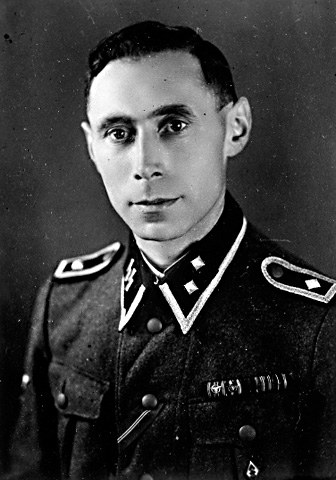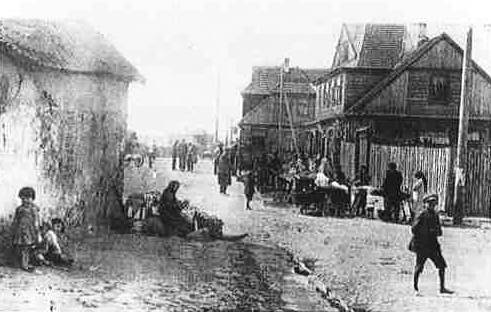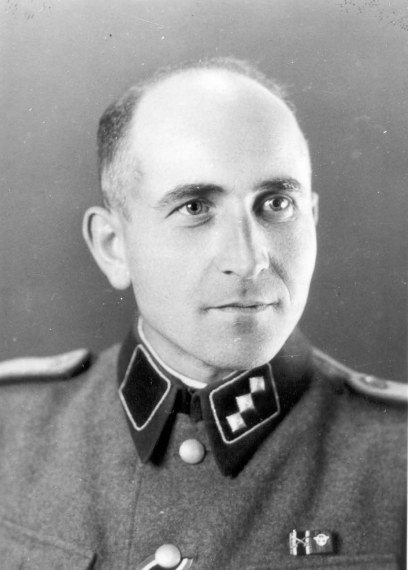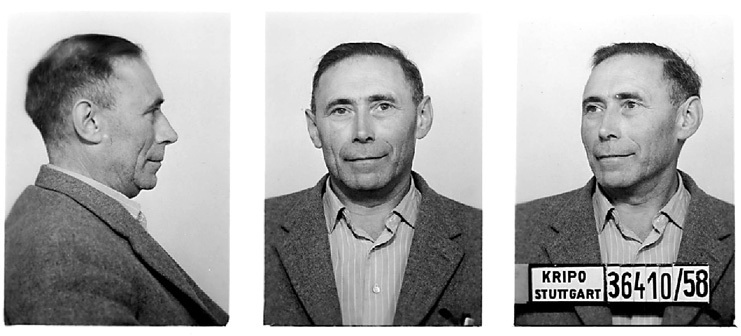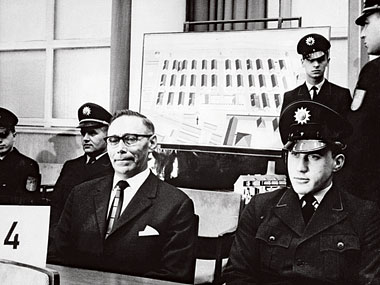Holocaust Education & Archive Research Team |
|
Other Camps
Key Nazi personalities in the Camp System The Labor & Extermination Camps
Auschwitz/Birkenau Jasenovac Klooga Majdanek Plaszow The Labor Camps
Trawniki
Concentration Camps
Transit Camps
|
|||
Wilhelm Boger Auschwitz – Political Department
Wilhelm Boger was born on the 19 December 1906 in Stuttgart- Zuffenhausen, the son of a local merchant who did not enjoy the best of reputations. Boger joined the National Socialist youth movement (later called the Hitler Youth) in 1922. Boger later recalled, “I was an old-timer in the Nazi movement.”
In the summer of 1925, after nine years of schooling and a three year apprenticeship in a business firm, he obtained a clerical job with the Stuttgart district office of the National German Commercial Employees Association.
Boger joined both the Nazi Party and the SA in 1929. Until the end of 1929 he was also a member of the Artaman League, an organisation that wished to substitute voluntary agricultural service for universal military service.
In the years following, Boger worked for a number of private business firms in Stuttgart, Dresden and Friedrichschafen. In 1930, while in Dresden he joined the SS.
Boger lost his job in the spring of 1932, a year later on 5 March 1933, as a member of the SS, he was called for duty in the auxiliary police of Friedrichschafen.
On 1 July 1933 he was transferred to the Stuttgart political emergency police corps and after another six weeks to the Württemberg political police, also at Stuttgart and in October 1933 to the offices of the Friedrichschafen political police.
He attended the police training school at Stuttgart between autumn 1936 and spring 1937, took the criminal police candidate examination and was appointed Kommissar in March 1937.
At the outbreak of the Second World War he was transferred to the state police office at Zichenau; after three weeks he was put in charge of setting up and supervising the border police station in Ostrolenka.
After a spell in a Gestapo prison in 1940 he was called up to the 2nd SS and Police Engineer reserve unit based in Dresden. After a brief training period, he was sent to the front and in March 1942 he was wounded.
In December 1942 he was transferred to the Auschwitz concentration camp. Boger served as an SS Staff Sergeant in the Political Department, this department was the representative of the RSHA in the camp and its chief responsibilities was keeping files on individual prisoners, the reception of prisoners, maintaining the security of the camp, combating resistance and conducting interrogations etc.
It was Wilhelm Boger who invented the “Boger swing” an instrument of torture which consisted of two upright beams, in which an iron pole was laid crosswise. Boger made the victim kneel, placed the iron pole across the backs of the knees, and then chained the victim’s hands to it.
Then he fastened the iron pole to the beams so that the victim hung with their head down and their buttocks up. In this way Boger wrung confessions out of his victims.
Josef Kral a Polish citizen arrested on 4 February 1940 in Vienna, was deported to Auschwitz in June 1941, and was interrogated by the Political Department in December 1942. He recalled at the Auschwitz trial in 1965:
“At first I didn’t know what it was all about. I was arrested in the basement of Block 17, a new building, brought to the Political Section, and left standing there in a hall.
I was taken into a room by Untersturmfuhrer Wosnitza and Grabner said, “At last we’ve got you. We’ll talk to you.” I saw Kirchner, Boger, Dylewski, and other SS men in the room. They said, “We are not the Gestapo, we are not the criminal police, we are the Political Section. We don’t ask - we only listen. You yourself must know what you have to tell us.” At a signal from Grabner somebody knocked me unconscious.
At that point I saw Boger standing next to me. When I came to again I was lying in the hall. My ankles hurt badly, as if someone had kicked me. When I opened my eyes I saw Boger standing next to me. Later I was again interrogated together with my comrades in the presence of Security Service men from Berlin. Boger interrogated and mistreated the prisoners till they died.
First Janicki was put on the swing, and tied hand and foot. One SS man put him into proper positions and two others alternated hitting him. They simply made mincemeat out of Janicki. He was torn to bits.
Afterwards Boger threw him out into the corridor. After a while he moved his lips, it was obviously that he was thirsty, because he stuck out his tongue all the way. Boger went over to him and pushed his head around with his boot.”
Boger remained at Auschwitz until its evacuation, when he accompanied prisoners, when he accompanied prisoners being transported to Germany. Toward the end of the war he was to have gone to the front from Ravensbruck, but his unit disintegrated, and he succeeded in making his way to his parent’s home in Ludwigsburg.
On the 19 June 1945 he was arrested by the American Military police. He was to have been extradited to Poland on the 22 November 1946, but he managed to escape at Cham, which probably saved him from execution in Poland.
For about three years he lived in the vicinity of Crailsheim under an assumed name. In 1950 he took a job at an airplane factory in Zuffenhausen. On the 8 October 1958 he was arrested and charged with complicity in the crimes of Auschwitz.
Boger and nineteen other former members of the Auschwitz –Birkenau garrison were tried before a court in Frankfurt –am – Main 1964/65, the so-called Auschwitz Trial.
Frau Braun a witnesses for the prosecution against Boger had the following to say after the trial:
"I almost fainted the first time she entered the courtroom and saw Wilhelm Boger himself. During the questions meant to establish his identity, I came close to utter collapse, having to face this now old man in civilian clothes, who stared into me eyes with cold rage." Frau Braun had been his private secretary and stenographer chosen to observe daily and take notes while he “interrogated” prisoners. SIt was her job to sit beside Boger daily, attending him not only in his office, but in that “chamber,” as we would term the place of torture.
Not all testimony at Bogers trial was as cut and dried, sever judges acknowledged that "the possibilities of verifying the witness declarations were very limited." This situation was underscored during the trial when former inmate Rudolf Kauer suddenly repudiated earlier statements about his one-time SS masters.
In pre-trial interrogation he claimed to have seen defendant Wilhelm Boger brutally beat a naked Polish woman with a horse whip, ripping off one breast and flooding a room with blood.
When asked to repeat his statement in court, Kauer admitted:
"I lied about that. That was just a yarn going around the camp. I never saw it ..."
Another claim that Boger had smashed an infant's skull against a tree trunk was also not true, he claimed. Although Boger was not liked, Kauer told the court, he was actually a just SS man. The court did not agree with Kauers claims and Boger was found guilty of murder and sentenced to life and an additional five years hard labour.
Sources: Auschwitz by Bernd Nauman, published by Pall Mall Press London 1966. The Auschwitz Chronicle by Danuta Czech, published by Henry Holt & Company New York 1990. International Military Tribunal, Trial of the Major War Criminals Before the International Military Tribunal. 42 vols. Nuremberg: 1947-1949. BundesArchiv Ludwigsberg Archive
Copyright: Victor Smart H.E.A.R.T 2008
|
